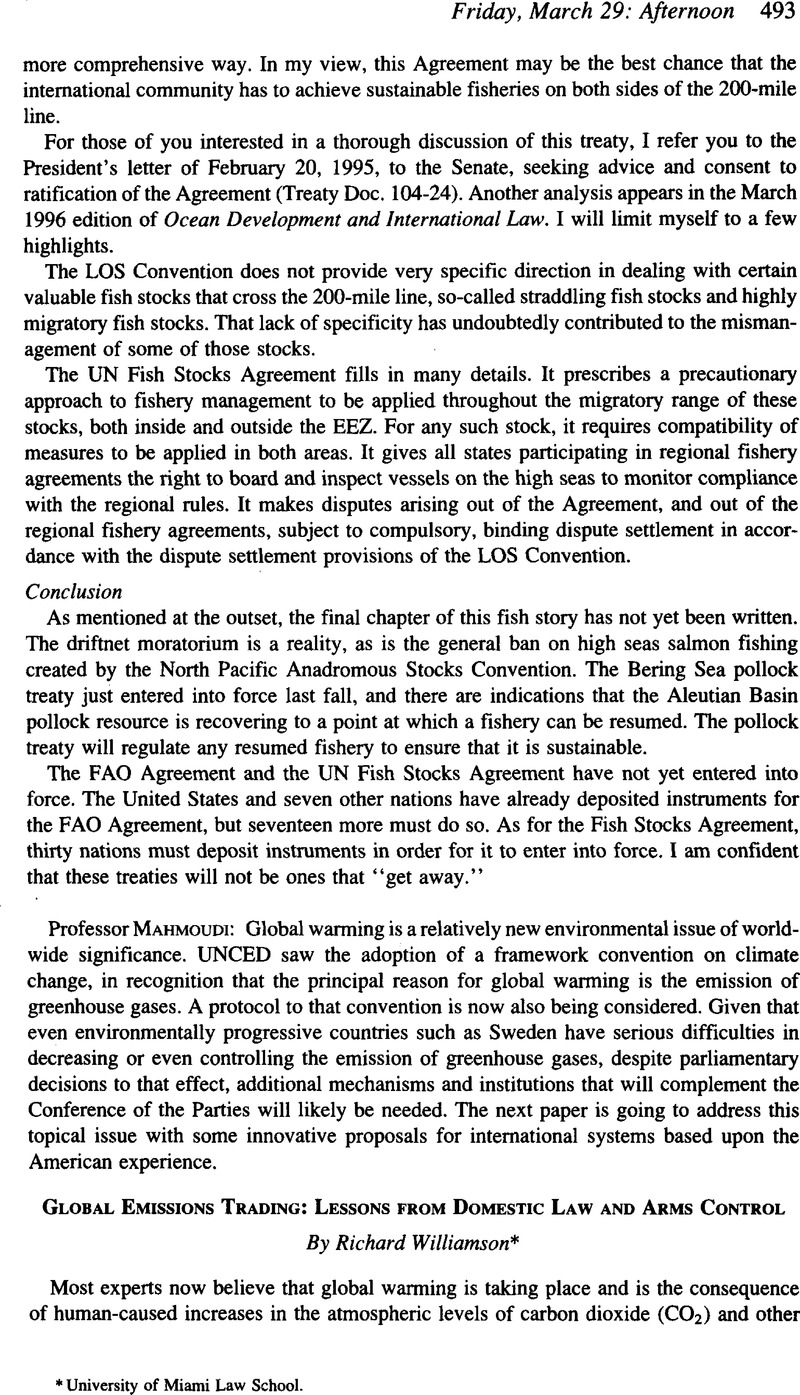No CrossRef data available.
Article contents
Global Emissions Trading: Lessons from Domestic Law and Arms Control
Published online by Cambridge University Press: 17 February 2017
Abstract

- Type
- Environment: New Institutional Challenges
- Information
- Copyright
- Copyright © American Society of International Law 2015
References
1 See Intergovernmental Panel on Climate Change, Second Assessment Report (1995).
2 United Nations Framework Convention on Climate Change, reprinted in 31 ELM 849 (1992).
3 Postcript: Since this talk, the United States reversed its position and announced its willingness to engage in negotiations looking toward “realistic, verifiable and binding medium term (post-2000) emissions targets.“ However, “the United States will continue to seek market-based solutions that are flexible and cost effective.“ Statement of Timothy E. Wirth, Undersecretary of State for Global Affairs before the Second Conference of the Parties, Framework Convention, July 17, 1996 at Geneva, Switzerland, reproduced in Making International Climate Change Process Work, 7 U.S. Deft, of State Dispatch (July 22, 1996).
4 For an example of an early work, see, e.g. W. Montgomery, Markets in Licenses and Efficient Pollution Control Programs, 5 Journal of Economic Theory 395 (1972).
5 Of course, increased efficiency in generating and transmitting power would not be the only means available to a society to control emission levels. These may not be available to a particular utility. Generally speaking, the most cost-effective measure is conservation by consumers. But public service commissions are increasingly unwilling to authorize new generating equipment being built without a utility first having a vigorous conservation program. Moreover, the society at large may not allow a utility to take credit for more general conservation measures because they may be the only way a government with a growing population can offset increases in greenhouse gas emissions from small, diverse sources such as transportation, home heating and air conditioning, very small enterprises, etc.
6 Article 4(2)(a) of the Framework Convention specifies that “Parties may implement such policies and measures jointly with other Parties....“ This led to a great deal of interest in “joint implementation“ projects between developed and developing countries, and these were endorsed at the April 1995 meeting of the Conference of the Parties in Berlin. Most of the projects in which the United States has participated so far involve sequestering carbon, rather than trading in emission rights. In a typical sequestration project, a utility in the United States assists in replanting cleared land in a developing country, thereby taking more carbon out of the atmosphere, and offsetting increased CO2 emissions by that utility. For further information on the current state of the U.S. Initiative on Joint Implementation, see 61 Fed. Reg. 59480 (Nov. 22,1996). Some of the administration and verification issues discussed in text concerning emissions trading also apply to sequestration projects.
7 42 U.S.C. §§7401–7671q.
8 Ozone is the principle harmful component of smog, and is the most widespread air pollution problem in the United States. However, virtually no sources emit significant quantities of ozone. Instead ozone arises from the atmospheric interaction of various volatile organic compounds (VOCs) and nitrogen oxides in sunlight. Fighting ozone has largely consisted of regulatory controls being placed on the emission of VOCs and other “ozone precursors.“
9 See generally Timothy N. Cason, An Experimental Investigation of the Seller Incentives in EPA's Emission Trading Auction (1993).
10 Details on the plans EPA has, and a discussion of the difficulties that led to the decision to create a new market-oriented mechanism to supplement the SIP-based approach, can be found in 60 Fed. Reg. 44,290 (1995) and 60 Fed. Reg. 39,668 (1995).


